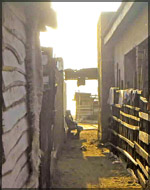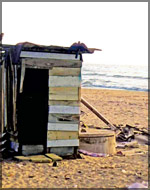|
Archwatch |
Compiled and
coordinated by Edward Arambewala |

Poorest of the poor
The objective of this discussion is to find ways of converting the
uncontrolled settlements to a positive development factor that can be
part of the city in its cohesive built environment, rather than an
impediment.
This is mainly because ‘city dwellers’ are considered as one of the
most important part of the city. Therefore this sector, simply cannot be
ignored, that it makes a part of the phenomenon of urbanization.
|

Unplanned settlements at railway reservation, Borella |
It can be transformed into a positive development and make it part of
the built spaces, rather than, an ignored unwanted, territories of the
city. Due to the ignorance of these areas, a close look at the patterns
of living, have not been done, and therefore some of the mitigatory
measures taken, have so far been failures to address their issues.
It is important to note that considerable section of urban population
live in an unauthorised areas, which are not designated for housing, and
which are below the specified standards of living.
Therefore one of the greatest phenomenon, is the ignored fact that in
the East, it is the employment of many social groups belonging to
different occupations, and social standards that run the city and its
buildings.
In the Eastern city, unlike in the West many things are functioned by
manual operations, and man power is the key to its function. Therefore
City and its function is a collective effort of all kinds of people and
an interesting spirit is created that is unique, with so much human
involvement.
As a result what we see in the Cities of the East cannot be traced in
a planned city of the West. It is true that the Western cities are clean
and healthy and every thing functions specifically, as planned etc.
But we all know that in our cities this is not happening and natural
circumstances always seem to govern in an instances such as these. For example as Charles Doidge, Director of Post Graduate studies, has
pointed out in seminar papers (1976), he mentions about such supports
that exist around the City buildings in Chandigarh, in the City of
India. ‘the secretariat building is backed by, boutiques and little
canteens in bicycles and huts’. He further states the need to have
places for the poor with in the rich economical settings of the city.
example as Charles Doidge, Director of Post Graduate studies, has
pointed out in seminar papers (1976), he mentions about such supports
that exist around the City buildings in Chandigarh, in the City of
India. ‘the secretariat building is backed by, boutiques and little
canteens in bicycles and huts’. He further states the need to have
places for the poor with in the rich economical settings of the city.
Life in these groups can be categorized into these types, the sources
of income, job structure, parental aspirations, child training, and
child rearing practices, living habits, slending habits, cohesive
community life, extended family life patterns, and dearth of resources,
space and materials, so these are identified as a reflection of the
characteristics of this type of housing.
Slums and Shanties have become the sharpest expression of housing
crisis in the city of Colombo. But people still exist in the urban
context among the crisis for their survival. The dwellers of these units
never fail to be isolated and they tend to maintain a certain unity
among themselves.
This unity is widely expressed in the form of a clustered dwellings,
identified as a “ watta” among themselves. The so called “watta” is a
special feature that enables to identify this particular category of
people. A number of spontaneous dwellings were examined with the case
studies to find out their physical, social and psychological structures
and how their responses of living. .
Three different “wathu” were identified in three different localities
as follows,
01. Settlements along Canal Bank Reservation
02. Settlements along Railway Reservation
03. Settlements along Coastal Reservation
|

Unplanned settlements at
Dematagoda near ‘Sahaspura’, |

Environmental hazards due to unplanned along canal bank |
Striving for Survival
An overall examinations reveal that their education standards are
very low that most of them depend upon odd jobs, in and around the city
of Colombo.
Also it indicates that they have been living in these areas for about
45-50 years of time. It is interesting to note the ways and means
adapted for their survival.
Some of the common things that were founded were, type of temporary
shelter, the limited space, the living conditions etc. Most of the
settlements are with facility of electricity and water and illegal
disposal of sewer.
Settlements along
Canal Bank Reservation Wellawatte
The dwellers who live along the Canal bank in Wellawatte area have an
eight hour working period and rest of the time they tend to be at their
|

Poor living environment for children |
dwelling units. Most of them are labourers attached to the
Municipal council of the same locality.
Some of the female too contribute to uplift their economy by working
as domestic servants in wealthy houses for a day pay or attached to the
municipal council. Even the female remain at home tend to add some
contribution for their family by running a small boutique beside the
dwelling unit.
Life patterns identified
Settlements along Railway Reservation
Most of the dwellers who live in Borella area are engaged in the
manning market. Most of the time they are out and involved in the
activities in the manning market and they search their dwelling unit
only for a short break.
Some of them are street vendors, peddlers, brokers, labourers etc.
The female too contribute to uplift their economy by working as domestic
servants in wealthy houses for a day pay or attached to the municipal
council. And few of the females are abroad working as housemaids.
Life patterns identified
|

Alley ways created in the
coastal settlements |

Alley ways created in the
coastal settlements |
Settlements along Coastal Reservation
The dwellers along the coastal belt in Moratuwa area are more or
less, home based. Most of them are engaged in carpentry and fishing.
Some of them have built their own industry adjacent to their dwelling
unit and engaged in preparing cheap timber items such as towel racks,
baby desks, toys etc. Some of them are attached to the surrounding
timber mills.
The female too contribute to uplift their economy by collecting
remnant cheap timber to prepare firewood. When considering the fishing
community, most of them work under a wealthy person who owns a boat and
they get a day pay and share of fish for their meals.
In addition when considering the all three localities the common fact
of all was that some of them are engaged in illicit activities such as
kasippu, drugs, ganja etc. But most of the males never fail to visit
these spots after work which has become a part of their day to day
activity.
ARCHWATCH Committee
Daily News – SLIA Architectural Advisory Forum
The Daily News, together with the Sri Lanka Institute of Architects,
invite you to forward in writing, your specific questions for advice,
with regard to Building Design and Construction, relating to Housing and
other Buildings, accompanied by supporting plans, sketches, partial
drawings, etc. to; Archt.Rehan Tilakaratna - Chairman, Board of
Architectural Publication, SLIA Sri Lanka Institute of Architects, 120/7
Vidya Mawatha, Colombo 7 and a copy to Mr. Edward Arambewala Co-ordinator,
Arch Watch Daily News, Lake House, Colombo 10.
The Advisory Forum Comprises
Architects Bernard Gomesz FIA (SL) Chairman
Prasanna Silva, FIA (SL)
Ranjan Nadesapillai FIA (SL)
Vasantha de Silva FIA (SL)
Viranjan Kurukulasuriya AIA
(SL) (Co-chairman)
Prasanna Kulatilake AIA (SL)
The Daily News/SLIA Architectural Housing and Building Advisory Forum
wish to thank all those readers who wrote to us commending the
re-commencement of this page.
We are interested in your ancestral homes
Archwatch is interested in your ancestral homes, if they are over 100
years old, and being maintained in the same way as they were built, with
no architectural design and style modifications or changes, done.
We feel that some of these homes should be preserved for their
architectural and cultural values, for future generations to see, study,
and adopt any aspects in them which may be found feasible to incorporate
into the present day designs, by the architects.
Sadly we find, as far as we know that most of these houses have
already been demolished and obliterated from the living architecture of
that period giving way to modern architectured buildings and homes. Only
a very few of them yet remain with the families who take pride in their
ancestral homes. We would like to feature these homes in this page, and
visit them for that purpose.
Hence we would like those families, who would not mind getting these
ancestral homes featured on this page, to write to:
The ArchWatch Co-ordinator
C/o Features Editor, Daily News, Lake House
35, D.R. Wijewardene Mawatha
Colombo 10.
Fax.429210
E-mail - [email protected]
A tool to create awareness
Travel, education through the print and electronic media have
contributed towards Interest and the appreciation of well designed
spaces not only for infrastructure but also to live in and call home.
Today as land prices and building costs escalate designing spaces is
not a luxury but a necessity as it makes possible to utilise spaces to
the maximum while considering the aesthetics too.
Therefore it becomes important to create awareness on not only the
basic aspects to consider “before you build” and during building but
also on aspects like interior decor, maintenance and renovations.
Archwatch page will give the Sri Lanka Institute of Architects the
opportunity and pleasure of creating awareness by means of features and
also to address you personally if you write into this page to inquire
about issues regarding construction.
I look forward with interest to see this page develop into a eagerly
anticipated vibrant by weekly issue.
Bernard Gomesz Chairman BAP-SLIA
Getting your building plans approved?
The Arch watch Forum of its meeting last week decided to help Arch
watch readers with resolving any problems and delays they may be
encountering in getting their building plans approved.
All you have to do is to write with details of your problem giving
all the details to Architect Viranjan Kurukulasuriya, Vice-Chairman,
ARCH Watch, Board of Architectural
Publications, Sri Lanka Institute of Architects, 120/7, Vidya Mawatha,
Colombo 7. Fax 682757.
Please don’t fail to send a copy of your letter to the ARCH Watch
Coordinator addressed to the Daily News, given elsewhere on this page. |

